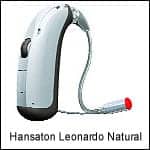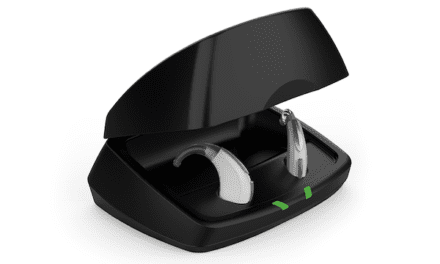Providing amplification to individuals with hearing loss in the high frequencies presents a challenge to hearing instrument designers. The patient with good hearing in the low frequencies requires a fitting that allows the escape of low frequency bone-conducted sounds—like the wearer’s own voice—from the ear canal to avoid the sensation of occlusion. In addition, the amplification system should not add noise that the wearer will be able to hear. Finally, the open nature of such a fitting means that unamplified sound will enter the ear canal directly and mix with amplified sound from the hearing instrument. Depending on the lag between the direct and amplified sound, the result can range from a slight alteration in the timbre of the incoming sound to a perception of reverberation.
A hearing instrument intended for fitting high frequency hearing losses, the ReSoundAIR from GN ReSound, has been developed to effectively address these challenges. The device is fit without occluding the ear canal, and features Stabilizer feedback cancellation to extend the amount of usable gain, allowing the fitting of a large range of high frequency hearing losses. It also utilizes an innovative compression system design that provides frequency shaping flexibility with minimal internal noise and distortion. Further, the sound processing time is exceptionally low.
This article describes the WarpOpen compression system for open hearing instrument fittings in ReSoundAIR hearing aids. The system consists of high-resolution frequency response shaping for soft sounds combined with a 3-band low distortion compressor, and low level expansion to ensure that no internal noise is audible.
Frequency Shaping System
A prerequisite for successful fitting of a wide range of high frequency hearing losses is flexibility and precision in shaping the frequency response. WarpOpen utilizes a high-resolution minimum-phase Finite Impulse Response (FIR) filter. Minimum-phase FIR filtering is a digital filtering technique that is particularly suitable for use where both continuous and transient signals are processed, and offers the lowest possible processing delay in a digital application. Speech recognition, pro-audio, video, and data transmission are some of the applications for which this type of filters are advantageous.
One particular benefit of this type of filtering is that the manner in which transient sounds are processed correspond better to auditory system processing than other digital filter techniques. The WarpOpen is the first hearing aid compression system to make use of this technique. The minimum-phase FIR filter used in the system corresponds to the resolution of the Cochlea Dynamics compression system used in the GN ReSound Canta series of hearing instruments. The settings of the filter determine the precise gain for soft and moderate level inputs to the hearing instrument.

Figure 1. An example of the way in which the compressor’s crossover bands change based on three different gain prescriptions. |
Compression Technique
Sensorineural hearing losses are characterized by reduced sensitivity for low sound levels; however, loudness perception at high levels is similar to that of normal hearing individuals. The capability to provide input level-dependent gain is the main rationale for use of wide dynamic range compression (WDRC) in hearing instruments.
The WarpOpen employs a 3-band filter bank system to achieve fast-acting WDRC separately from the frequency-shaping system described above. A signal processing technique, called frequency warping, enables variable cross-over frequencies in the compressor filter bank. Depending on the desired gain settings, the cross-over frequencies are automatically adjusted to best approximate the response. Examples of how the compressor’s band structure changes based on the gain prescription are shown in Figure 1. The frequency warping technique is designed to offer better processing efficiency and virtually no cross-over region distortion. This means that there are no dips or bumps in the frequency response of the compression part of the system.
Like the compressor used in the existing Canta series, the WarpOpen compressor is controlled by a number of gain handles for soft and loud gain. The fitter sets the gain for these inputs using a number of frequency handles as shown in Figure 2, and these settings are transformed to control the system. The crossover frequencies in the filter bank are automatically optimized so it is not necessary—or possible—for the fitter to adjust them manually.

Figure 2. Control of the compression system in the
fitting software. The dispensing professional specifies
the gain for soft and loud input levels at different
frequencies. System parameters are automatically
adjusted to achieve the desired response.
Placing the Compression Before the Frequency Shaping
Figure 3 shows the structure of the WarpOpen system. A unique characteristic is that the system which determines the compression is placed before the frequency-shaping portion of the system. The 3-band filter bank is utilized to provide power estimates of the incoming sound. The output of the filter bank is used to compute how much gain should be reduced (compared to the gain for low sound levels). That is, negative gain values are derived, and these values are added to the gain determined by the frequency-shaping part of the system.

Figure 3. Unlike other compressors, the system places frequency
shaping after determination of compression, thereby eliminating
contamination of input power estimates.
The advantage of placing the compression part of the system in front of the frequency-shaping portion is that the estimates of the input power are thereby accurate. The drawback in performing the frequency shaping first—as done in other commercially available systems where frequency shaping and compression are implemented separately—is contamination of the input power estimation. If the input power estimation is not accurate, the compression applied will not be based solely on the level of the input signal; rather, it will be heavily influenced by how the system is set to amplify low level sounds. This has the important implication that gain for all sound levels can be lower or higher than desired.
Open Fitting Capabilities
The compressor in this device was designed especially for open fittings. As mentioned, in the case of an open fitting, the combination of direct and amplified sound in the ear canal may negatively affect sound quality if the time taken by the system to process the sound is too long. This means that a low propagation delay is mandatory. By using the warped filter bank and the minimum-phase FIR filter, the propagation delay is kept at the theoretical minimum. The compressor has a propagation delay of less than 3.5 ms at 1600 Hz, which has been shown to be imperceptible to listeners with high frequency hearing losses.1
However, a low propagation delay does not guarantee optimum conditions for an open fitting. One of the potential advantages of an open fitting is improved localization ability.2,3 Therefore, it is important to ensure that interaural directional cues are not lost in the signal processing. To accomplish this, it is essential that the delay does not change over time. Traditional low-delay filter bank structures change their delay quite drastically when the compressor alters gains due to changes in input power. This phenomenon is completely avoided with the WarpOpen because of the system’s choice of filter structures which has a fixed propagation delay regardless of the input level of incoming sounds.
Low Noise and Distortion
The compressor was designed to keep distortion as low as possible. Normally a compression system would implement an infinite compression point in each of the bands. However, in compressors with few non-overlapping bands, such as the WarpOpen system, this results in “bumps” in the frequency response at the cross-over frequencies. This can cause distortion at those frequencies. The compressor has a single broadband output compressor (MPO limiter) to ensure that no such bumps occur.
As a result of the design advantages described above, the compressor has very low internal noise and distortion. As a further precaution against circuit and microphone noise, a low level expansion system has been implemented in the device. This system reduces gain for very low input levels, ensures that internal noise is inaudible, and that low level environmental noise is not overamplified.
Summary
Successful provision of amplification to individuals with high frequency hearing losses requires open fittings which, in turn, places demands on the amplification system. These include flexible frequency shaping, compression to compensate for reduced dynamic range, extremely low noise and distortion, and a low propagation delay. The new system employs technology including minimum-phase FIR filtering and frequency warping that is designed to meet these demands. In addition, the system architecture provides the desired gain for varying sound levels.
| This article was submitted to HR by Jennifer Groth, MA, senior research audiologist, and Brian Dam Pedersen, MScEE, DSP software engineer, at GN ReSound in Copenhagen, Denmark. Correspondence can be addressed to HR or Jennifer Groth, GN ReSound, Maarkaervej 2A, Postbox 224, DK-2630, Taastrup, Denmark; email: [email protected]. |
References
1. Groth J, Olsen SØ, Søndergaard M. Disturbance of DSP group delays for non-occluding fittings. Paper presented at: Annual Convention of the American Academy Audiology; April 2003; San Antonio.
2. Byrne D, Sinclair S, Noble W. Open earmold fittings for improving aided auditory localization for sensorineural hearing losses with good high-frequency hearing. Ear & Hear. 1998;19(1):61-71.
3. Noble W, Sinclair Sm Byrne D. Improvement in aided sound localization with open earmolds: observations in people with high-frequency hearing loss. Jour Amer Acad Audiol. 1998;9:25-34.





